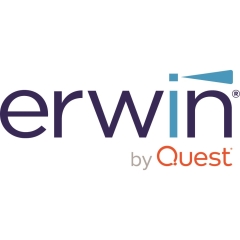Data Intelligence is a data management solution that connects to various data sources. It also provides data profiling and data quality management.

Data Intelligence is a data management solution that connects to various data sources. It also provides data profiling and data quality management.
erwin enhances our overall data governance process, improving the business as well as our ability to meet compliance and reporting requirements.
The solution helps us save time and understand our data better. For example, you can search for keywords or discover assets by classification, feedback, and rating. You can sort assets by the highest or lowest rating. It has reduced the time spent on these tasks by about 20 percent.
The interface is easy to use. I also like erwin's automatic data classification and data quality checks. It provides excellent visibility into stable data and data in motion. We have a clear view of ETL processes through data lineage, and a feature called the data mind map.
erwin provides the necessary traceability. It's easy to assign tasks and keywords. Data owners can manage their data and assign access to various teams.
The data catalog dashboard enables us to classify sensitive data and comply with regulations, which is crucial in Saudi Arabia. Every government organization must abide by the rules on personal data. I rate the data catalog dashboard nine out of 10.
The solution's Arabic language processing is limited. The results are limited when you use the interface in Arabic.
I have used erwin for six months.
I rate erwin customer support nine out of 10. We purchased premium support, which is crucial because we have a lot of customers who require a quick response.
Positive
The deployment is straightforward, and we deployed erwin with a three-person in-house team. It took us about six hours to complete the configuration because it takes time to connect the data sources, which must be configured separately. You need to define the data source, identify the server where each database is located, enter the server ID, input the connection string, etc.
We have seen a return, but I can't say how much.
erwin's license is about average. You have to pay extra for smart connectors if you need to add data sources that won't work with the standard connector.
We tried Talend and a few other solutions. The primary benefit erwin offered was automation. It helps us reduce manual work.
I rate erwin Data Intelligence nine out of 10.
We use erwin Data Intelligence to map the data structures from the source systems to our logical data model. Based on this mapping, the tool automatically generates ETL procedures for us.
The solution saves us time and reduces the number of bugs by automatically generating software, rather than manually creating it.
The solution saves time in data discovery and understanding our entire organization's data.
The technical support could be improved. When we had an issue, we were given vague answers that did not resolve the issue.
I have been using erwin Data Intelligence for three years.
The solution is stable.
The solution is scalable.
We have Premier Support, which provides us with quick access to the support team. However, it does not accelerate the resolution of our issues. It took almost a year for us to get the impression that they were listening to us. It took another half a year for them to understand the issue, and another half a year to resolve it.
Neutral
We previously used Excel spreadsheets to do the mapping before switching to erwin Data Intelligence for the automation.
The price is too high. We pay 41,000 Swiss francs for five users.
I give the pricing a three out of ten.
I give erwin Data Intelligence an eight out of ten.
Premier Support has added minimal value to our overall investment.
I recommend doing a POC for erwin Data Intelligence before moving forward to ensure that it meets all requirements.
